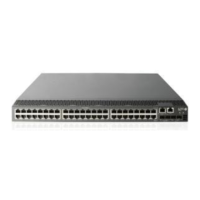70
Using the device as an FTP server
If the device is operating as an FTP server, make sure the following requirements are met to ensure
successful FTP operations:
• The device and the FTP server can reach each other.
• Configure a user account (including the username, password, and authorization) on the device or
a remote authentication server for an FTP user. This task is required because the device does not
support anonymous FTP for security reasons. By default, authenticated users can access the root
directory of the device.
• The FTP user provides the correct username and password.
NOTE:
hen you use the Internet Explorer browser to log in to the device operating as an FTP server, some FTP
functions are not available. This is because multiple connections are required during the login process bu
the device supports only one connection at a time.
Configuring basic parameters
The FTP server uses one of the following modes to update a file when you upload the file (use the put
command) to the FTP server:
• Fast mode—The FTP server starts writing data to the Flash after a file is transferred to the memory.
This prevents the existing file on the FTP server from being corrupted in the event that anomaly, such
as a power failure, occurs during a file transfer.
• Normal mode—The FTP server writes data to the Flash while receiving data. This means that any
anomaly, such as a power failure, during file transfer might result in file corruption on the FTP server.
This mode, however, consumes less memory space than the fast mode.
To configure basic parameters for the FTP server:
Step Command Remarks
1. Enter system view.
system-view N/A
2. Enable the FTP server.
ftp server enable By default, the FTP server is disabled.
3. Set the DSCP value for IPv4 to
use for outgoing FTP packets.
ftp server dscp dscp-value
Optional.
The default is 0.
4. Use an ACL to control FTP
access.
ftp server acl acl-number
Optional.
By default, no ACL is used for access
control.
5. Configure the idle-timeout
timer.
ftp timeout minutes
Optional.
The default idle-timeout timer is 30
minutes.
If no data is transferred within the
idle-timeout time, the connection is
terminated.
6. Set the file update mode for
the FTP server.
ftp update { fast | normal }
Optional.
By default, normal update is used.

